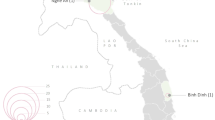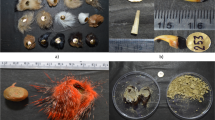Abstract
We examined an online sold product “Hatha Jodi” synonym of “paired arm” for the confirmation of its biological source. It was declared as a plant root. The morphological features of these samples were matched with the “intromittent organs” or “hemi penis” of the monitor lizard. For further confirmation, we used sequencing of a partial fragment of mitochondrial DNA cytochrome b gene. Sequence comparison indicated that these claimed plant products were actually biological samples of a common monitor lizard, Varanus bengalensis. Hence, it exhibited the ongoing illegal trade of the intromittent organ of a prohibited species with a misleading name using low risk and widely adopted modern trading method that imposes a severe challenge for combating against the wildlife crime.

Similar content being viewed by others
References
Holland K (1994) Medicine from animals: from mysticism to science. Pharm Historian 24:9–12
Borah MP, Prasad SP (2016) Ethnozoological remedial uses by the indigenous inhabitants in adjoining areas of Pobitora wildlife sanctuary, Assam, India. Int J Pharm Pharm Sci 8(4):1–7
Cooper JE, Cooper ME (2007) Introduction to veterinary and comparative forensic medicine. Blackwell, Oxford
Lawton MPC, Cooper JE (2009) Wildlife crime scene visits. Appl Herpetol 6:29–45
Cooper JE, Cooper ME, Budgen P (2009) Wildlife crime scene investigation: techniques, tools and technology. Endanger Species Res 9:229–238
Verheij PM, Foley KE, Enge K (2010) Reduced to skin and bones: an analysis of tiger seizures from 11 tiger range countries (2000–2010). TRAFFIC International, Cambridge
Bennett E (2011) Another inconvenient truth: the failure of enforcement systems to save charismatic species. Oryx 45:476–479. https://doi.org/10.1017/S003060531000178X
Gupta SK, Verma SK, Singh L (2005) Molecular insight into a wildlife crime: the case of a peafowl slaughter. Forensic Sci Int 154:214–217
Gupta SK, Jyotsana B, Thangaraj K, Singh L (2011) Establishing the identity of the massacred tigress in a case of wildlife crime. Forensic Sci Int Genet 5:73–74
Vipin SV, Gupta SK (2017) Molecular identification of victim species and its sex from the ash: a case of burning alive leopard (Panthera pardus). Int J Leg Med 6:1–4. https://doi.org/10.1007/s00414-017-1619-1 In Press
PAW (Partnership for Action against Wildlife Crime) (2005) Wildlife crime: a guide to the use of forensic and specialist techniques in the investigation of wildlife crime. Department for Environment, Food and Rural Affairs, Bristol
Gray JE (1870) On the claspers of male lizards. Ann Mag Nat Hist 7:283
Cope ED (1896) On the hemipenes of the Sauria. Proc Acad Nat Sci Phil 48:461–467
Branch WR (1982) Hemipeneal morphology of platynotan lizards. J Herpetology 16:16–38
http://indiabiodiversity.org/species/show/33168 accessed on 15 September 2017
Vishnoi A (2017) Rage on e-commerce site, ‘Rare Herb’ Hatha Jodi myth busted http://economictimes.indiatimes.com/articleshow/59292486.cms?utm_source=contentofinterest&utm_medium=text&utm_campaign=cppst
Verma SK, Singh L (2003) Novel universal primers establish identity of enormous number of animal species for forensic application. Mol Ecol Notes 3:28–31
Altschul SF, Madden TL, Schaffer AA, Zhang J, Zhang Z, Miller W, Lipman J (1997) Gapped BLAST and PSIBLAST: a new generation of protein database search programs. Nucleic Acids Res 25:3389–3402
Thompson JD, Higgins DG, Gibson TJ (1994) CLUSTAL W: improving the sensitivity of progressive multiple sequence alignment through sequence weighting, position-specific gap penalties and weight matrix choice. Nucleic Acids Res 22:4673–4680
Hall TA (1999) BioEdit: a user-friendly biological sequence alignment editor and analysis program for windows 95/98/NT. Nucleic Acids Symp Ser 41:95–98
Kumar S, Stecher G, Tamura K (2016) MEGA7: molecular evolutionary genetics analysis version 7.0. Mol Biol Evol 33:1870–1874. https://doi.org/10.1093/molbev/msw054
Hickman CP, Roberts LS, Larson A (2001) Integrated principles of zoology, 11th edn. McGraw-Hill, New York ISBN 0–07–290961–7
Benarjee G, Srikanth K, Ramu G, Ramulu KN (2010) Ethnozoological study in a tropical wildlife sanctuary of Eturunagaram in the Warangal district, Andhra Pradesh. Ind J Trad Knowledge 9:701–704
Khan MZ, Abbas D, Ghalib SA, Siddqui S, Siddiqui TF, Yasmeen R, Yasmeen G, Abbas D, Zehra A (2012) Current status and distribution of reptiles of Sindh. J Basic Applied Sci 8:26–34
Hashmi MUA, Khan MZ, Amtiyaz HN (2013) Current status, and distribution and threats of Varanus species (Varanus bengalensis and V. griseus) in Karachi and Thatta of Sindh. Int J Fauna Biol Studies 1:34–38
Das D (2015) Ethnozoological practices among tribal inhabitants in Khowai district of Tripura, north-East India. J Global Biosci 4:3364–3372
Bagde N, Jain S (2015) Study of traditional man-animal relationship in Chhindwara district of Madhya Pradesh, India. J Global Biosci 4:1456–1463
Harkare LJ, Gawande PJ, Baviskar BS, Latha BR, Hippargi R, Jayraw AK, Maske DK (2007) Infestation of tick Aponomma gibsoni (Acari: Ixodidae) in monitor lizard Varanus bengalensis from Nagpur, Maharashtra. Zoo Print J 22:2898
Gupta SK, Kumar A, Hussain SA, Vipin SL (2013) Cytochrome b based genetic differentiation of Indian wild pig (Sus scrofa cristatus) and domestic pig (Sus scrofa domestica) and its use in wildlife forensics. Sci Justice 53:220–222
Wultsch C, Waits LP, Kelly MCJ (2014) Noninvasive individual and species identification of jaguars (Panthera onca), pumas (Puma concolor) and ocelots (Leopardus pardalis) in Belize, central America using cross-species microsatellites and faecal DNA. Mol Ecol Resour 14:1171–1182
Acknowledgments
The support provided by Dr. V. B. Mathur, Director; Dr. G. S. Rawat, Dean; and Dr. Y. V. Jhala, Nodal Officer, Forensic Lab, WII, are acknowledged. The authors thank Shri. R.S. Sarath, Inspector, WCCB, for his assistance in this study. The forest departments and enforcement agencies are acknowledged for sending the biological samples for forensic opinion.
Funding
This study was funded by the Wildlife Institute of India (WII).
Author information
Authors and Affiliations
Corresponding author
Ethics declarations
Competing interests
The authors declare that there have no competing interests.
Electronic supplementary material
ESM 1
(DOCX 80 kb)
Rights and permissions
About this article
Cite this article
Sharma, C.P., Kumar, A., Vipin et al. Online selling of wildlife part with spurious name: a serious challenge for wildlife crime enforcement. Int J Legal Med 133, 65–69 (2019). https://doi.org/10.1007/s00414-018-1795-7
Received:
Accepted:
Published:
Issue Date:
DOI: https://doi.org/10.1007/s00414-018-1795-7




